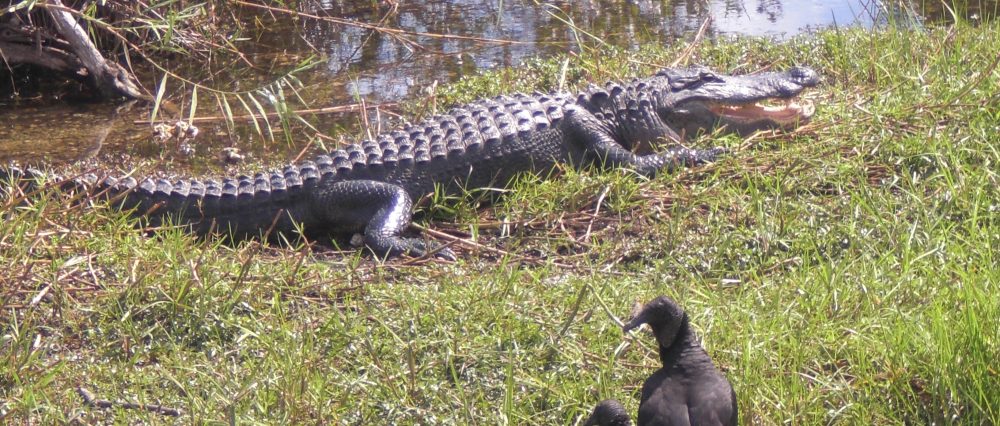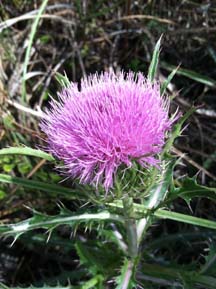A chronology from 2000 to today
December, 2000 — President Bill Clinton signed the first phase of an ambitious $ 8‑billion Everglades restoration plan, which sets into motion 68 separate projects designed to bring the Everglades back to life. “This is a very happy day for the Everglades, and it is a signal day for the improvement of the world trying to repair damaged environmental ecosystems,” said Sen. Bob Graham, D‑Fla. “There has never been an effort of this scale or complexity that is now under way to save a dying environmental system.” – St. Petersburg Times
June, 2001 – President George W. Bush visited the Florida Everglades to highlight his commitment to the proposed restoration plan. The President hiked the Anhinga Trail, named for a bird that inhabits the Everglades. ”The president’s been looking for an opportunity to go down there to talk about what’s in the budget to protect the Everglades,” said a White House spokeswoman. — Associated Press
August, 2001 – Signaling the importance of the Everglades, the National Audubon Society magazine for the first time
in a decade devoted its entire issue to one subject — the restoration of the Everglades. “One of our writers compares the Everglades to Africa without the lions and zebras,” said Executive Editor David Seideman. “It really is so exotic. There’s nothing like it anywhere in the world.” – Associated Press.
December, 2001 – The U.S. Army Corps of Engineers released the long-awaited rules designed to govern the restoration of the Everglades but environmental organizations called them a recipe for failure. The rules were more general than what environmentalists had wanted, but met the objectives of sugar farmers, water utilities and Florida Gov. Jeb Bush. – Washington Post
May, 2002 – Florida Gov. Jeb Bush signed a bill authorizing the state to borrow about $100 million to buy land to get the federal-state restoration underway. While some environmental groups applauded others criticized it because of an attached provision that could make it harder to challenge developers accused of harming the environment. – Associated Press
June, 2002 – A Washington Post series stated that the Everglades restoration plan was “riddled with uncertainties,” forged by intense political pressure brought by commercial interests and may primarily benefit Florida homeowners, agribusinesses and developers. The restoration plan was called “a multipurpose plumbing project — committed to expanding water supplies and ensuring flood control for South Florida’s exploding population as well as to improving water flows to the Everglades.” – Washington Post
August, 2002 — The prestigious National Academy of Sciences warned that the Everglades restoration project might trigger algae blooms and kill sea grasses in nearby Florida Bay. A peer-reviewed report by a panel of scientists stated that the Everglades project’s impact on the 1,000-square-mile bay was highly uncertain, challenging assumptions that the bay would become a fisherman’s paradise. – Washington Post
September, 2002 – David Struhs, head of Florida Department of Environmental Protection, told a U.S. Senate oversight committee that the Everglades restoration was on schedule in most areas. The government had acquired about three-quarters of the land needed for the first 10 engineering and water storage projects. – Miami Herald
December, 2002 — The U.S. Army Corps of Engineers announced it had missed a deadline for completing the final regulations to guide the Everglades restoration plan. Officials at the Army Corps could not say when the rules would be completed but most concerned parties expressed caution support. – Palm Beach Post
April 2003 — The head of Florida’s environmental protection agency said that rules to enforce water quality in the Everglades should be delayed by 20 years. Environmental Protection Secretary David Strohs said that scientists are unlikely to figure out how to insure that water quality will be kept high by a Dec. 31, 2006 deadline. — Palm Beach Post
May 2003 — Governor Jeb Bush signed a bill that would give farmers and water managers an additional 10 years to clean up the Everglades over the objections of environmentalists and others. Water managers said they would move faster in improving water quality but it would depend how rapidly science issues were resolved. — Palm Beach Post
October 2003 — Officials broke ground on the first of the 68 projects being financed by the $7.8 billion state and federal restoration of the Everglades. The first project was the restoration of 55,000 acres of an abandoned development called Southern Golden Gates Estates outside of Naples, Fla.- Greenwire
November,2003 — New federal rules to guide the Everglades restoration were unveiled and immediately attacked by environmentalists who said they give too much power to the U.S. Army Corps of Engineers and turn the restoration into a huge water project. Gov. Jeb Bush and U.S. Interior Secretary Gale Norton praised the new rules. — Palm Beach Post
February, 2004 — A new pumping station that cost $197 million began operating that is designed to filter billons of gallons water from sugar cane and farm fields before it reaches the Everglades. The pump will send the water into a newly constructed wetland where plants and algae will soak up potentially damaging nutrients. — Associated Press
July, 2004 — Costs have risen for the Everglades restoration and the first two major projects, expected to cost $1.1 billion, instead came in at $1.6 billion. Officials said that inflation seemed to be a primary reason for the increase. — Associated Press
September, 2004 — Some local officials called for a moratorium on development in the agriculture district after sugar growers in Palm Beach County began signaling that they might use some of their land for purposes other than farming. Florida Crystals Corp., one of the state’s two biggest sugar growers, had proposed developing 14,500 acres and luring the Scripps Research Institute to the area. United States Sugar Corp said it was planning to turn 4,000 of its acres into a lime rock mine. — Palm Beach Post
September, 2004 — Four hurricanes have swept across Florida in two months, devastating Lake Okeechobee by shredding plants, scaring off wading birds and leaving water at dangerously high levels. Biologists said it demonstrated the fragility of the lake, which is contained by a dike and is a water resource that is critical to the Everglades — Associated Press
October, 2004 — With federal work on the Everglades project lagging, Gov. Jeb Bush, announced a plan in which the state would borrow another $1.5‑billion to speed up the restoration. — St. Petersburg Times
February, 2005-President Bush’s 2006 fiscal year budget called for a nine percent decrease in the Army Corps’ budget, but it allocated more funding to the Everglades and land along the Louisiana Coast. The Everglades received $18 million more with this budget. “It shows the administration’s commitment to Everglades restoration. –Environment and Energy Daily
May, 2005- A lack of federal funding jeopardized plans to restore the Picayune Strand, a 55,000-acre piece of land that wildlife and developers had abandoned, and that could be a test for whether the Everglades restoration effort was working. The goal was to convert this parcel of land back into prime habitat for wildlife. The Army Corps of Engineers has confirmed that it was tens of millions of dollars behind schedule. –Environment and Energy Publishing
February, 2006 – Overflows from Lake Okeechobee have caused serious algae blooms in Caloosahatchee and St. Lucie Rivers, costing the local fishing and tourist industries millions of dollars. Now as part of the Everglades restoration project the U.S. Army Corps of Engineers has proposed spending $1 billion to reroute the rivers and restore them to their original form. – St. Petersburg Times
April 2006 – Work on the Everglades restoration has been slow and the Corps estimated that the price tag was now $10 billion because of inflation. Despite the delays, some work is now underway and the state agreed to provide $1.5 billion on eight key projects that will be finished by 2010 instead of their original projected date of 2020. –Southeast Construction
September, 2006 – Environmentalists, tourism officials and civic leaders said that they support a plan to build an 11-mile bridge on the Tamiami Trail in order to bring more water to Everglades National Park. But federal officials, who are working on plans for two smaller bridges, said the cost of such a bridge would be too expensive. – South Florida Sun-Sentinel
September, 2006 — A new report commissioned by Congress reported that there have been “troubling delays” in implementing the Everglades restoration. While the report praised the planning and scientific work it found that none of 10 planned projects were completed by their 2005 deadline. – South Florida Sun-Sentinel
November, 2006 – The state’s plan to expedite work on the Everglades rose in cost from the original $1.5 billion to $2.7 billion in just two years. State officials blamed the increases on rising construction costs and expansions in the original plan. – Palm Beach Post
January 2007 – Gov. Charlie Crist pledged to start moving forward with the restoration of the Everglades after years of delays. He and Sen. Bill Nelson, D‑Fla., hope to see more support from the federal government in the near future. – St. Petersburg Times
April 2007 – The Everglades will no longer be used as a source of water for cities along the southeast coast of Florida. Counties with “existing permits” will still be able to remove water, but there will be a limit as to how much they can take and no new permits will be issued. The new rules would force cities to find alternative sources of water and help with the protection of the environment. – St. Petersburg Times
May 2007 – The U.S. Army Corps of Engineers reversed its decision to reject the Mirasol Project, which would allow developers to build 800 homes and two golf courses on 650 acres of wetlands. Critics had expressed concern about whether the Corps was restoring the Everglades or helping to destroy. – St. Petersburg Times
June 2007 – A reservoir project was being planned to provide more water storage for the southern region of the Everglades Agricultural Area. It would cost 400 million and provide 62 billion gallons of aboveground space for water storage. – Southeast Construction
September 2007 – The U.S. Army Corps of Engineers recently completed work on a poorly constructed 550-acre reservoir. The reservoir cost $34 million and it leaks when it is only 38 percent filled. If it isn’t fixed, there is a risk of flooding for nearby residences. Repairs will cost approximately $13 million. – St. Petersburg Times
November 2007 – President Bush vetoed the 2007 Water Resources Development Act, a $23 billion bill which would have provided funding for several water-related projects, including $2 billion to go towards Everglades’ restoration. The veto was overturned by Congress — St. Petersburg Times
November 2007 — Richard Harvey, head of the U.S. Environmental Protection Agency’s South Florida office and the top water quality expert in Florida, was removed from the Everglades’ restoration project. He was fired from the project after voicing his concerns about the methods the Army Corps of Engineers was using to solve the pollution problem at Lake Okeechobee. Four other experts were removed from the project before Harvey for similar reasons. – St. Petersburg Times
March 2008 – Construction should begin soon in a remote section of Palm County on 22 miles of levee that would contain the largest free-standing above-ground reservoir in the world. The $600 million project to be completed in 2010 would gradually release water, which would otherwise be pumped out to sea, into an adjoining storm water treatment area. – South Florida Sun-Sentinel
June 2008 – Governor Charlie Crist announced that Florida would pay U.S. Sugar Corp. $1.75 billion to acquire 187,000 acres of land below Lake Okeechobee. Supporters hailed the plan, Florida’s largest land acquisition ever, as equivalent of the decision more than a century ago to create Yellowstone National Park. Critics charged that the state was overpaying and bailing out U.S. Sugar. – New York Times
July 2008 – A federal judge harshly criticized the state of Florida’s decision in 2003 to relax pollution standards that affect the Everglades and to delay enforcement of the standards until 2016. Judge Alan S. Gold issued an order blocking the Florida Department of Environmental Protection from issuing permits that don’t meet a limit of 10 parts per billion for phosphorous in runoff into the Everglades from farms, cities and Lake Okeechobee. — Palm Beach Post
December, 2008 – South Florida water managers agreed to buy most of U.S. Sugar Corp.’s land for $1.34 billion on one condition – that they could back out of the deal if the state’s finances worsen. Board members of the South Florida Water Management District said that their first priority remained water management and flood control as opposed to real estate transactions negotiated by the governor. — Palm Beach Post
March, 2009 — Governor Crist announced that Florida has significantly reduced it’s $1.34 billion deal to buy land from U.S. Sugar. The previous deal had Florida buying 180,000 acres and that has been cut to a more “modest” deal of $530 million for 72,500 acres with an option to buy the rest by 2019. – New York Times
July 2009 – With the discovery of an excessive amount of pythons roaming South Florida, efforts began to eradicate the species from the Everglades. Many people believe that homeowners dumped the snakes in the Everglades after realizing how huge the pythons grow in full length, and now there are up to tens of thousands of them residing in South Florida. First stages of the python hunting could take up to three months, and they could expand from there depending on the progress made. — Associated Press
January 2010: The Everglades Coalition said its plan for the next ten years includes cleaning up the water, work on restoring the land bought from US Sugar once the deal is complete and continue to encourage Congress’s involvement. At the conference, experts also discussed the significant progress in the Tamiami Trail and Picayune Strand projects. –States News Service
February 2010: Recreating the original flow of water from Lake Okeechobee has turned out to be more complicated than originally thought. Several Native American burial grounds have been found in the areas to be flooded. Officials said that they would have to find a way to avoid such sites. — South Florida Sun Sentinel
April 2010: A US district judge ruled that clean up in the Everglades, especially the lowering of phosphorous levels in the water, was moving too slowly. He blamed the US Environmental Protection Agency as well as the Florida Department of Environmental Protection for not following his 2008 ruling and he threatened to fine the two government agencies. –South Florida Sun Sentinel
August 2010: The Miccosukee tribe said that it was opposed to the pending land deal with U.S. Sugar Corp. and requested a federal judge to stop it. The tribe believed that the money used to purchase the land should go to other restoration efforts. A judge refused their request. — South Florida Sun Sentinel
October 2010: US Sugar Corp. said that it completed its sale of 26,800 acres, which is a further reduction of the original land deal proposed by Gov. Charlie Crist. The deal cost taxpayers $197 million. While some were ecstatic about the deal, others continued to believe that the cost was too high, especially when the money could have been put into restoration projects currently underway. –South Florida Sun-Sentinel
April 2011 – U.S. District Judge Alan S. Gold issued an order criticizing the water quality plans of Gov. Rick Scott and how it related to the Everglades. Gold also indicated that the state was doing such a poor job that he intended to turn over enforcement of federal water pollution standards back to the U.S. Environmental Protection Agency. — Palm Beach Post
June 2011 – Florida Agriculture Commissioner Adam Putnam said it was urgent that repairs be made to the Herbert Hoover dike surrounding Lake Okeechobee in order to free more water to farmers when droughts arrive. Because of concerns about the safety of the dike, water levels on the lake are kept at a level below what farmers prefer and repairs on some sections of the dike have been stalled. — Palm Beach Post
October 2011 – The U.S. Army Corps of Engineers unveiled a new plan designed to reduce planning and policy decisions regarding the Everglades restoration from six years down to two. “Perfect is the enemy of good,” said Stu Applebaum, the Corps’ chief of policy and planning. “We need timely and good decisions, not perfect decisions.” -
Palm Beach Post
January 2012 – Gov. Rick Scott had a new plan to redirect the slow-moving state and federal Everglades restoration plan. The new plan called on using existing state land to cut costs by using a core group of reservoirs and treatment areas to clean stormwater and replenish the Everglades. — South Florida Sun-Sentinel





